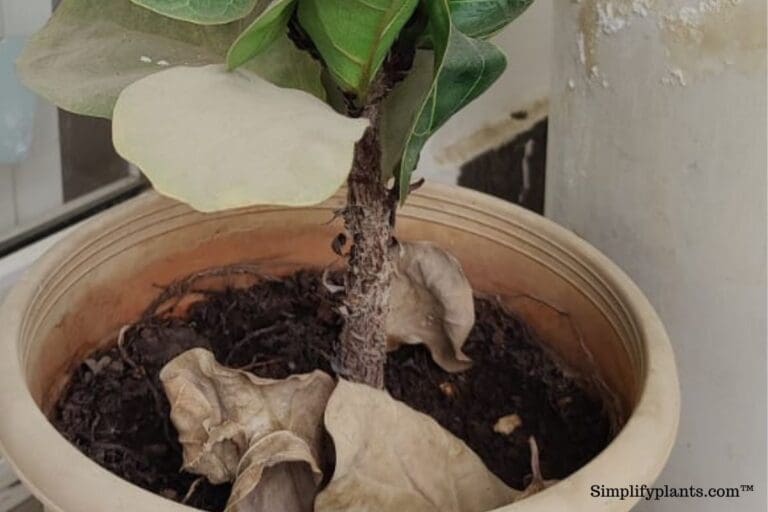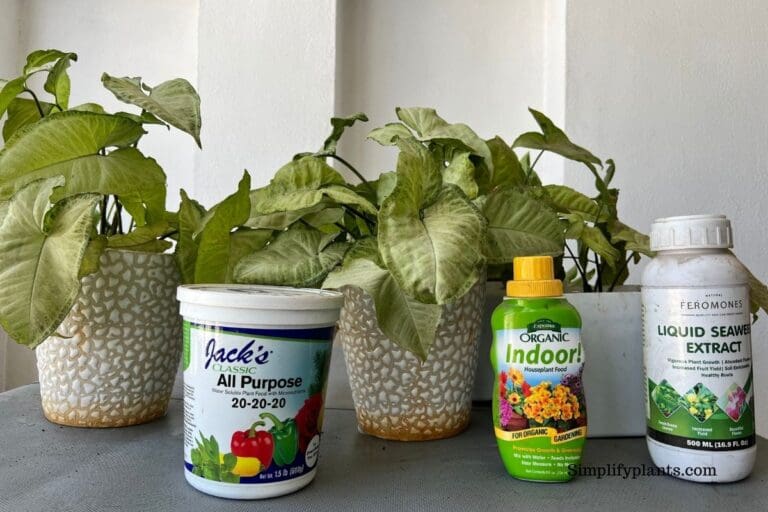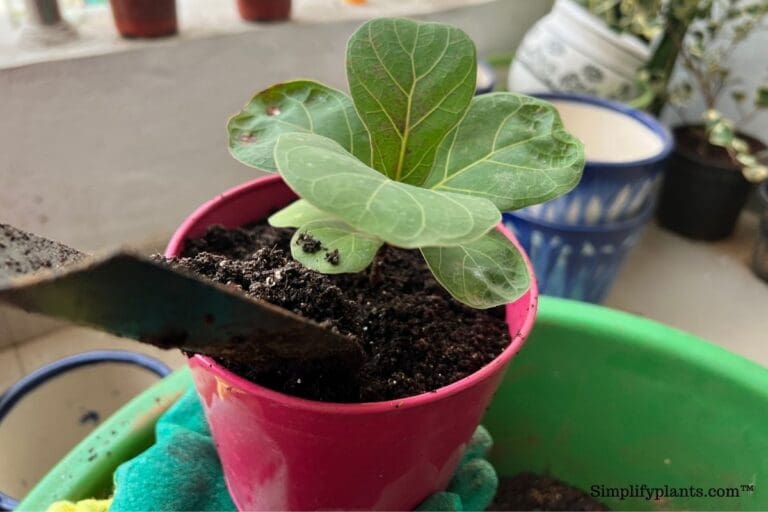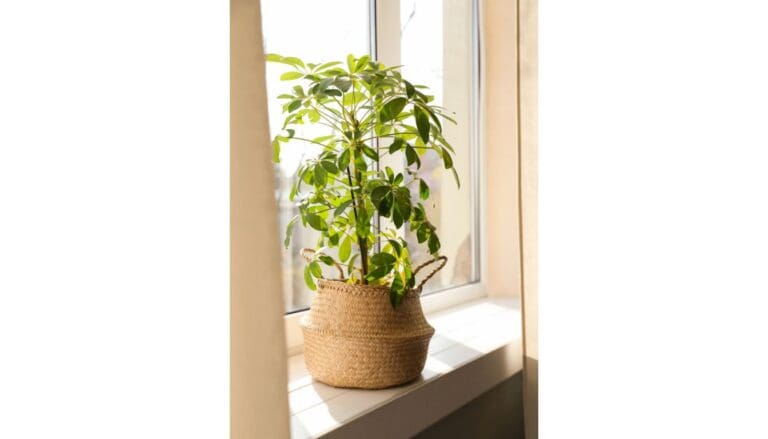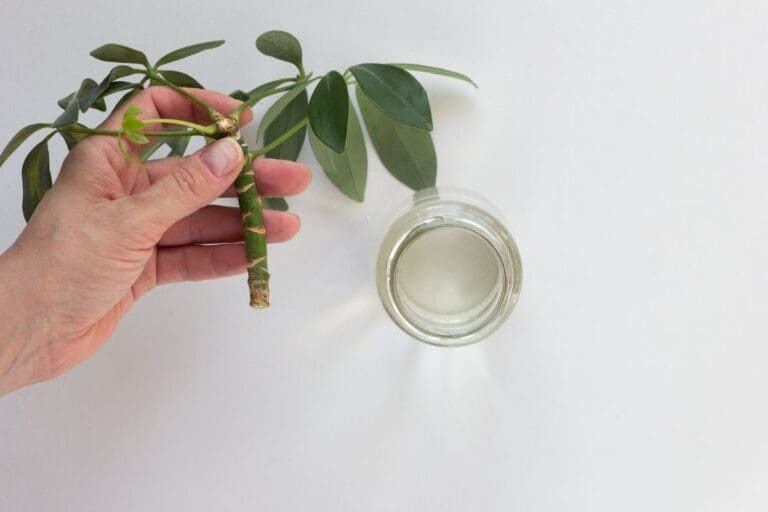10 Tips to Make a String of Pearls Plant Bloom
Growing a String of Pearls plant brings a unique touch of elegance to any indoor space. The trailing succulent’s small, round leaves create a delicate cascading effect that makes it a favorite among plant enthusiasts like me.
With the right care and conditions, I can make my String of Pearls produce tiny white flowers that smell like cinnamon. These special plants need specific attention to reach their full blooming potential, and I’ve gathered the best tips to help them thrive and flower.
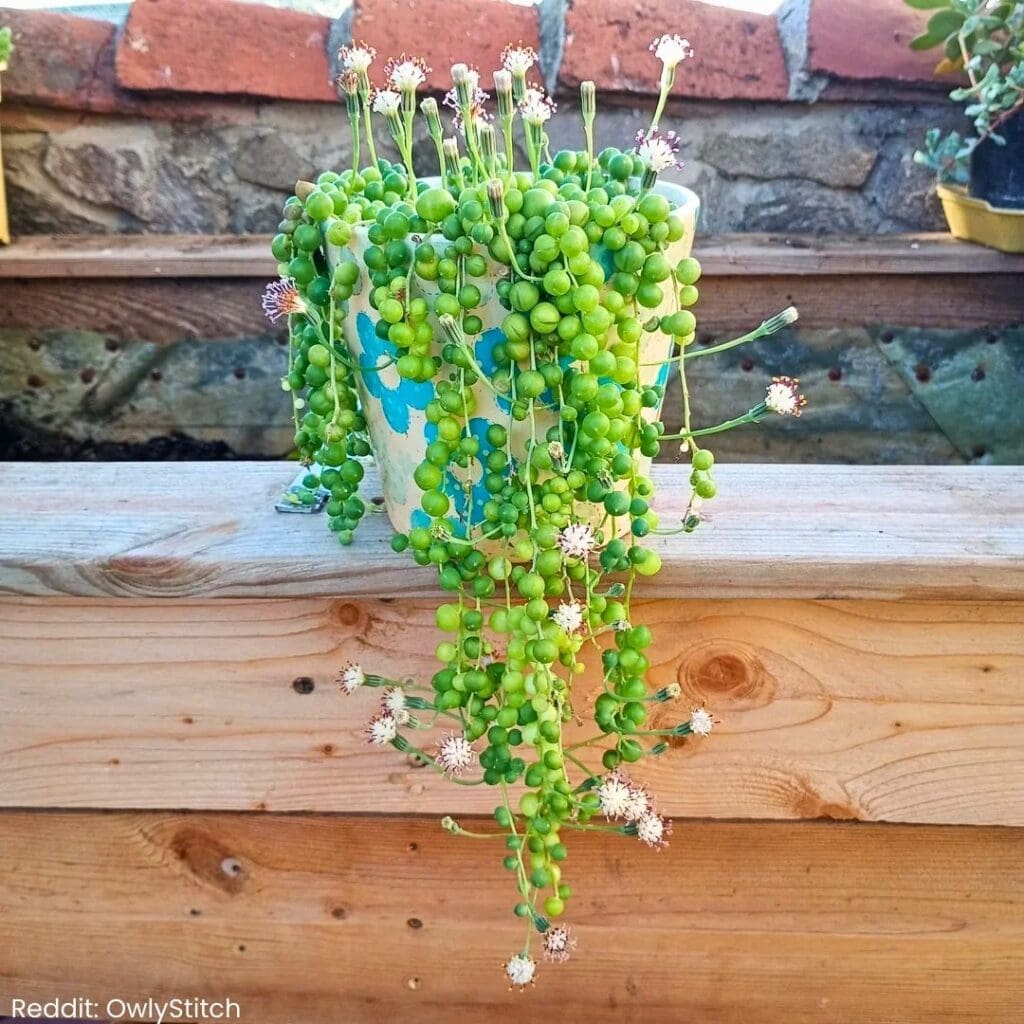
Please note: Simplify Plants is reader-supported. As an Amazon Associate, I earn from qualifying purchases made by our readers with no extra cost added to you all! Some links in the post are affiliate links and I get a commission from purchases made through links in the post.
1) Ensure Adequate Light Exposure
I’ve found that bright, indirect sunlight is essential for making String of Pearls plants bloom. These plants need at least 6 hours of light each day to produce their small white flowers.
The best spot I recommend is near an east or west-facing window. This gives your plant the perfect amount of morning or afternoon sun without burning its delicate pearl-shaped leaves.
In winter months, I move my String of Pearls closer to the window. The shorter days mean less light, so getting as much natural brightness as possible helps encourage blooming.
If your home doesn’t get enough natural light, I suggest using a grow light for 8-10 hours daily. Place the light about 12 inches above your plant to prevent leaf damage.
Watch out for signs that your plant isn’t getting enough light. If the pearls start looking pale or the gaps between them grow larger, move it to a brighter location.
Too much direct sun can harm your plant. I know my String of Pearls is getting too much light when the pearls start turning red or brown. When this happens, I move it back from the window or add a sheer curtain for protection.
2) Maintain Proper Watering Schedule

I’ve found that proper watering is key to getting a String of Pearls plant to bloom. These plants need a careful balance of moisture to trigger flowering.
Water deeply but only when the soil’s top inch feels completely dry to the touch. I check this by sticking my finger into the soil – it’s a simple but effective method.
During spring and summer, I water my String of Pearls about once every 7-10 days. These are the prime growing seasons when the plant needs more moisture to support blooming.
In fall and winter, I cut back watering to once every 2-3 weeks. The plant goes into a rest period during these months, and too much water can prevent blooming.
I always make sure my pot has good drainage holes. Standing water is bad news for these plants and can stop them from flowering. After watering, I empty any water that collects in the saucer.
Signs of overwatering include mushy pearls and stem rot. If I see these, I immediately reduce watering. On the flip side, shriveled pearls tell me the plant needs more water.
When I water, I pour it directly onto the soil and avoid getting the pearls wet. This helps prevent rot and creates better conditions for blooming.
3) Use a Well-draining Soil
I recommend using a mix of cactus soil and perlite for String of Pearls plants. This combination creates perfect drainage and prevents root rot, which often stops these plants from blooming.
The ideal soil mix is 60% cactus soil and 40% perlite. I’ve found this ratio works great for keeping the roots healthy while still holding enough moisture for the plant to thrive.
I always make sure to add some coarse sand to the mix too. This extra ingredient helps water flow through quickly and keeps air flowing around the roots. Your String of Pearls will love this well-aerated environment.
When I repot my plant, I check that the new pot has drainage holes at the bottom. Even the best soil mix won’t work properly if water can’t escape from the container.
I never reuse old soil for my String of Pearls. Fresh, clean soil gives the plant the best chance to produce those lovely white flowers. Plus, it helps prevent pest problems that can stop blooming.
The plant will tell you if the soil is working well. Healthy, plump pearls are a sign that your soil mix is just right. If the pearls look wrinkled or the stems are rotting, the soil might be too dense.
4) Provide Humidity Boost

String of pearls plants love humid environments, and I’ve found that increasing moisture in the air can encourage blooming. I keep my plant happy by misting it lightly with water 2-3 times per week.
Creating a pebble tray is one of my favorite tricks. I place a shallow tray filled with small stones under the plant’s pot and add water just below the pebbles’ surface. As the water evaporates, it creates a perfect humid microclimate.
I’ve noticed that grouping my string of pearls with other plants helps too. Plants naturally release moisture through their leaves, so placing them together creates a more humid space.
The bathroom can be an ideal spot for these plants during their growing season. The steam from showers provides natural humidity that string of pearls plants love.
I make sure not to overdo it with humidity. These plants still need good air circulation to prevent rot. A small fan nearby helps maintain airflow while keeping the moisture levels balanced.
During winter months, I reduce misting since the plant needs less moisture. I watch the pearl beads closely – if they start to look wrinkled, that’s my signal to increase humidity again.
5) Fertilize Sparingly With Balanced Fertilizer
I recommend using a balanced fertilizer with equal parts nitrogen, phosphorus, and potassium (like 10-10-10) for String of Pearls plants. The key is not to overdo it – these plants need very little fertilizer to thrive.
I feed my String of Pearls only during the growing season from spring through summer. I apply fertilizer once every 4-6 weeks, diluted to half strength. This gentle approach prevents burning the delicate roots.
During fall and winter, I stop fertilizing completely. The plant needs this rest period, and too much feeding can actually prevent blooming. Less is more when it comes to fertilizing String of Pearls.
I’ve found that organic fertilizers work great too. Fish emulsion or worm castings provide gentle nutrition without the risk of chemical burn. Just remember to dilute these as well.
If I notice yellow leaves, it might mean too much fertilizer. In this case, I flush the soil with plain water and wait a few months before feeding again. Healthy String of Pearls have plump, green pearls that show they’re getting just the right amount of nutrients.
6) Regularly Prune for Healthy Growth

I always make sure to prune my String of Pearls plant every few months. This helps remove any dead or yellow strands and encourages new growth.
When I spot brown or shriveled stems, I cut them off right away with clean scissors. This stops problems from spreading to the healthy parts of the plant.
The best time I’ve found for major pruning is during spring and summer. I trim back long strands to about 3-4 inches from the soil, which makes the plant look fuller.
I save the healthy cuttings I remove during pruning. These pieces can grow into new plants when I put them in soil, so nothing goes to waste.
Regular pruning helps my String of Pearls grow more strands from the top. I notice that trimmed plants produce more leaves and look bushier than unpruned ones.
I make sure to clean my scissors with rubbing alcohol before and after pruning. This simple step prevents spreading any plant diseases.
After pruning, I give my plant a little less water for a week. This lets it heal and focus on growing new stems instead of trying to support damaged ones.
7) Control Pests and Diseases Promptly
I recommend checking your String of Pearls plant weekly for any signs of pest problems. Common pests include mealybugs, spider mites, and scale insects. These tiny bugs can stop your plant from blooming.
If I spot any pests, I use neem oil spray to get rid of them right away. Mix 2 teaspoons of neem oil with 1 quart of water and spray it on the affected areas. This natural solution works great and won’t harm the plant.
Root rot is another issue I watch for. When I water too much or use soil that doesn’t drain well, the roots can start to rot. I make sure to only water when the top inch of soil feels dry.
To prevent diseases, I give my plant good air circulation. I keep it away from other plants and use a small fan if needed. Good airflow helps stop fungal problems before they start.
If I see any damaged or diseased stems, I remove them right away with clean scissors. This keeps problems from spreading to healthy parts of the plant. I always clean my tools between cuts with rubbing alcohol.
8) Repot Only When Necessary

I’ve learned that String of Pearls plants prefer to be slightly root-bound. This actually helps trigger blooming, so I avoid repotting too often.
I only repot my String of Pearls when I see roots growing out of the drainage holes or if the plant starts to look cramped. Usually, this means repotting every 2-3 years.
When I do need to repot, I choose a container just one size bigger than the current pot. Too much extra space can lead to root rot and fewer flowers.
I always use fresh, well-draining cactus soil when repotting. This gives my plant the best chance to settle in quickly and continue producing those sweet-smelling blooms.
Spring is the perfect time to repot my String of Pearls. I’ve noticed the plant adapts better to its new home during the growing season.
After repotting, I wait at least two weeks before fertilizing. This gives the roots time to heal from any damage during the transfer process.
9) Rotate Plant for Even Light Distribution
I’ve noticed that String of Pearls plants can grow unevenly when they only get light from one direction. Rotating your plant every few days helps create balanced growth and increases the chances of blooming.
I recommend turning the pot about a quarter turn every 3-4 days. This simple habit ensures all sides of the plant receive equal amounts of sunlight, which promotes fuller growth and more uniform pearl development.
When I forget to rotate my String of Pearls, I often see the stems stretching toward the light source. This creates a lopsided appearance and reduces the likelihood of flowers forming. Regular rotation prevents this stretching and keeps the plant looking full and healthy.
I find it helpful to mark one side of the pot with a small sticker. This makes it easy to track how much I’ve rotated the plant and maintain a consistent schedule.
The best time to rotate your plant is during your regular watering routine. This makes it easier to remember and turns it into a natural part of plant care.
Even light exposure strengthens the entire plant and creates the perfect conditions for producing those sweet-smelling white flowers. I’ve seen much better blooming success since I started this practice.
10) Check for Signs of Stress

I’ve noticed that stressed String of Pearls plants rarely produce flowers. When my plant shows brown or yellow leaves, I know it needs attention fast.
Common stress signs include shriveled pearls, dropping leaves, and soft mushy stems. I check these signs weekly to catch problems early. A healthy plant has firm, plump pearls with a bright green color.
I pay special attention to the soil moisture. If the soil stays wet for too long, the roots can rot. When I see black stems near the soil, it tells me the plant is getting too much water.
Too much direct sun can burn the pearls and cause stress. I watch for bleached or scorched spots on the leaves. Moving the plant a few feet away from the window often fixes this issue.
Pest problems can stress the plant too. I look under the leaves and along the stems for tiny bugs like mealybugs or spider mites. A quick wipe with rubbing alcohol on a cotton swab gets rid of most pests.
When I fix these stress issues, my String of Pearls usually starts blooming within a few months. A happy, stress-free plant puts more energy into making those sweet-smelling flowers.
Ideal Blooming Conditions
I’ve found that String of Pearls plants need specific conditions to produce their tiny white flowers. The most important factor is bright, indirect sunlight for at least 6 hours daily.
Temperature plays a big role too. I keep my plant between 70-80°F (21-27°C) during the day and slightly cooler at night. These plants love a temperature drop at night – it helps trigger blooming.
Good air circulation is essential. I place my String of Pearls near a window that I can open occasionally for fresh air, but away from cold drafts.
The plant needs a rest period in winter. I reduce watering and keep temperatures slightly cooler from December to February. This rest period helps encourage spring blooming.
Proper watering is critical for flowers. I let the soil dry out completely between waterings, but never keep it dry for too long. A moisture meter helps me get it just right.
Key Blooming Requirements:
- Light: Bright indirect sunlight
- Temperature: 70-80°F day, cooler nights
- Humidity: 40-50%
- Soil: Well-draining succulent mix
- Water: Allow soil to dry between waterings
I avoid fertilizing during the winter rest period. When spring arrives, I use a balanced liquid fertilizer at quarter strength once a month to support blooming.

Frequently Asked Questions
Growing String of Pearls plants takes specific care and attention to help them thrive and produce their sweet-scented flowers. These tips and solutions will help you succeed with your plant.
How can I encourage my String of Pearls plant to flower?
I’ve found that bright indirect light is key to getting blooms. Place your plant near a south or west-facing window.
Temperature fluctuations between 60-70°F at night and 70-80°F during the day can trigger flowering.
Keep the soil slightly dry during winter months. This rest period helps stimulate blooming in spring.
What are the common issues with String of Pearls plants and how can I address them?
Yellow pearls often mean too much water. I recommend waiting until the top inch of soil feels dry before watering.
Shriveled pearls point to underwatering or low humidity. Try misting the plant lightly once a week.
Pest problems like mealybugs can be treated with neem oil or insecticidal soap.
Could you guide me on how to propagate a String of Pearls plant?
Take 4-inch stem cuttings with several pearls attached. Remove pearls from the bottom inch of the stem.
Let the cuttings dry for 24 hours, then place them in well-draining soil.
Keep the soil lightly moist until you see new growth, usually within 2-3 weeks.
What are the signs of overwatering versus underwatering in a String of Pearls plant?
Overwatered plants have mushy, translucent pearls that may burst easily. The stems often turn black near the soil.
Underwatered plants show wrinkled, flat pearls. The stems might look dried out and crispy.
When is the typical blooming season for String of Pearls plants?
String of Pearls typically bloom in late spring to early summer.
Flowers are small, white, and smell like cinnamon. They usually last about a week.
What are some tips for creating a fuller and healthier String of Pearls plant?
Trim long stems regularly to encourage branching and fuller growth.
I rotate my plant a quarter turn weekly for even growth on all sides.
Feed with balanced fertilizer monthly during the growing season, but skip feeding in winter.
Note: Some images in the articles are sourced from Reddit and Other Platforms For Reference Purpose.

